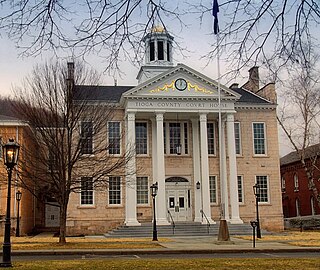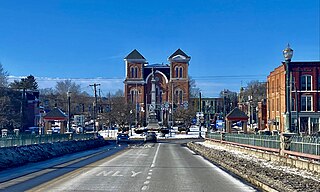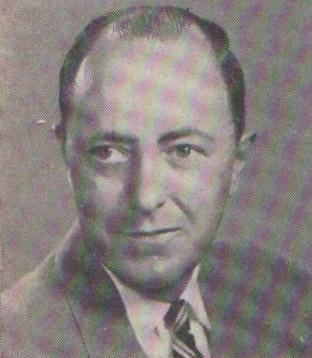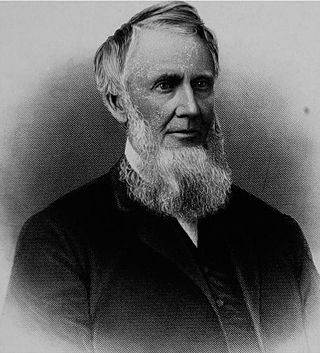
Tioga County is a county in the U.S. state of New York. As of the 2020 census, the population was 48,455. Its county seat is Owego. Its name derives from an American Indian word meaning "at the forks", describing a meeting place.

Tioga County is a county in the Commonwealth of Pennsylvania. As of the 2020 census, the population was 41,045. Its county seat is Wellsboro. The county was created on March 26, 1804, from part of Lycoming County and later organized in 1812. It is named for the Tioga River. Tioga County is in the sparsely populated Pennsylvania Wilds region.
Richford is a town in Tioga County, New York, United States. The population was 1,052 at the 2020 census. The town is named after Ezekial Rich, an early settler and benefactor of the town.
Tioga is a town in Tioga County, New York, United States. The population was 4,455 at the 2020 census. The town is in the southwestern part of the county and lies between Elmira and Binghamton. Tioga is situated in the Southern Tier District of New York.
Newark Valley is a town in Tioga County, New York, United States. The population was 3,660 at the 2020 census. The town is named after the city of Newark, New Jersey.

Owego is a town in Tioga County, New York, United States. The population was 18,728 at the 2020 census. The name is derived from the Iroquois word Ahwaga, meaning "where the valley widens".
Spencer is a town in Tioga County, New York, United States. The population was 2,976 at the 2020 census. The town and its primary village are named after Ambrose Spencer. It lies on the western border of the county and is south of Ithaca. Inside the town is the Village of Spencer. The village of Candor borders the town to the east and southeast, with Waverly to the southwest and Van Etten to the west, while Danby is to the north.

Austin Blair, also known as the Civil War Governor, was a politician who served as the 13th governor of Michigan and in Michigan's House of Representatives and Senate as well as the U.S. Senate. He was known as a strong opponent of slavery and secession. He also led efforts to provide women and black citizens the right to vote. He simultaneously sought to ban capital punishment.

Gilbert Carlton Walker was a United States political figure. He served as the 36th Governor of Virginia, first as a Republican provisional governor between 1869 and 1870, and again as a Democrat elected governor from 1870 to 1874. He was the last Republican governor of Virginia until Linwood Holton took office in 1970.

Thomas Collier Platt, also known as Tom Platt and Easy Boss, was an American politician who was a two-term member of the U.S. House of Representatives (1873–1877) and a three-term U.S. Senator from New York in 1881 and 1897 to 1909. He is best known as the "political boss" of the Republican Party in New York State in the late 19th century and early 20th century. Upon his death, the New York Times stated that "no man ever exercised less influence in the Senate or the House of Representatives than he," but "no man ever exercised more power as a political leader." He considered himself the "political godfather" of many Republican governors of the state, including Theodore Roosevelt.

John Mason Parker was an American Congressman from New York's 27th congressional district.

Howard Winfield Robison was a Republican member of the United States House of Representatives from New York.

Stephen Fowler Wilson was an American lawyer, politician and judge from Pennsylvania who served as a Republican member of the U.S. House of Representatives for Pennsylvania's 18th congressional district from 1865 to 1869. He also served as a member of the Pennsylvania State Senate for the 1st district from 1863 to 1865.

Amasa Dana was an American lawyer and politician who served two non-consecutive terms as a U.S. Representative from New York from 1839 to 1841, and from 1843 to 1845.
Caleb Baker was an American politician and a U.S. representative from New York.
Daniel Cruger was an American newspaper publisher, lawyer and politician who served as a United States representative from New York.

John James Taylor was an American attorney and businessman. He is most notable for his service as a U.S. Representative from New York, a position he held from 1853 to 1855.
John Reuben Drake was a U.S. Representative from New York.
Stephen Strong was an American lawyer and politician and one term as a U.S. Representative from New York from 1845 to 1847.
Tioga Terrace is a neighborhood and census-designated place (CDP) in the town of Owego, Tioga County, New York, United States. It was first listed as a CDP prior to the 2020 census.


















